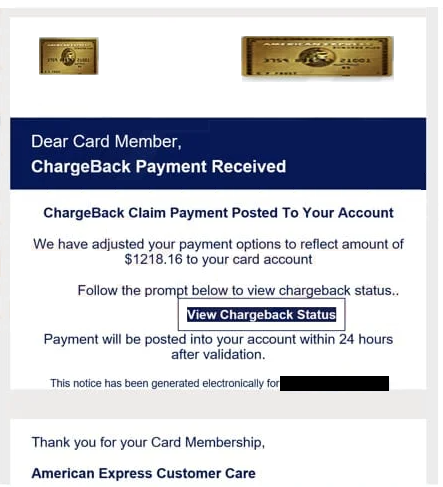Remove “American Express – ChargeBack Payment” email scam
The “American Express – ChargeBack Payment” email is part of a phishing campaign that aims to steal users’ American Express account login credentials. The email falsely claims that a chargeback of $1218.16 has been successfully adjusted and can be reviewed by clicking on the provided button. However, if users click on the button, they will be taken to a fake American Express site that asks users to log in. If users fall for this phishing campaign and try to log in, their login credentials will be sent to malicious actors who could use them to gain access to users’ accounts. This could lead to financial losses.
The “American Express – ChargeBack Payment” email scam is a generic phishing attempt that targets American Express users. The email claims that a chargeback claim payment has been posted to the recipient’s account, specifically $1218.16. This payment will supposedly be posted into the account within 24 hours of validation. If users want to view the chargeback status, they can supposedly do so by clicking on the “View Chargeback Status” button.
The full contents of the “American Express – ChargeBack Payment” phishing email:
Subject: The chargeback has been successfully adjusted
Dear Card Member,
ChargeBack Payment Received
ChargeBack Claim Payment Posted To Your Account
We have adjusted your payment options to reflect amount of $1218.16 to your card account
Follow the prompt below to view chargeback status..
View Chargeback Status
Payment will be posted into your account within 24 hours after validation.This notice has been generated electronically for *******
Thank you for your Card Membership,
American Express Customer Care
If users click on the button, they will be taken to a fake American Express website and asked to log in. If users type in their credentials and try to log in, the credentials will be transferred to the malicious actors operating this campaign. This could lead to cybercriminals gaining access to the account and stealing the funds in it.
Users’ personal and financial information is in high demand among cybercriminals, which is why these types of phishing campaigns are so common. It’s important that users learn to identify phishing emails if they want to avoid becoming victims.
What are the signs of a phishing email?
When it comes to phishing campaigns that target many users with the same email, it’s not difficult to identify them because of how generic they are. These emails typically lack specific details and are frequently full of grammar and spelling mistakes. However, we should mention that more sophisticated phishing campaigns target specific people whose personal information has been obtained by cybercriminals. Such emails will appear much more legitimate. They are, therefore, more likely to deceive recipients. Fortunately for most users, they are usually targeted with generic and easy-to-recognize emails.
If you receive an unsolicited email requesting you to click on a link or open an attachment, the first step is to check the sender’s email address. A quick Google search can help you confirm whether the email address matches the identity the sender claims to represent. Generic malicious emails usually come from random-looking email addresses, whereas more advanced phishing attempts often use addresses that resemble those of legitimate companies or organizations. If an email address looks even remotely suspicious, you should not interact with the email.
Another telltale sign of phishing emails is poor grammar and spelling. Many phishing emails contain noticeable mistakes. For example, this “American Express – ChargeBack Payment” phishing email is very poorly written and phrased awkwardly. Legitimate emails from legitimate senders, especially banks, will not have mistakes in them because they look very unprofessional.
This particular “American Express – ChargeBack Payment” phishing email also addresses the recipient as “Card Member”, which is an immediate giveaway. Emails from banks always address users by name, generic words like “User”, “Member”, “Customer”, etc., are often signs of a malicious email.
It’s a good idea to take your time to check everything when you receive an email that prompts you to take action, such as clicking a link or opening an attachment. Thoroughly review the email for signs of legitimacy. If there’s a link, hover over it with your mouse to see where it’ll take you before clicking. In case of attachments, scan them with an anti-virus program or VirusTotal before opening them. If an email suggests there’s a problem with your account, don’t click any links; instead, log into your account directly to verify any issues.
Finally, always check the URL of a website before logging in. Phishing sites can closely mimic legitimate ones, but their URLs will always give them away.
Remove “American Express – ChargeBack Payment” email scam
You can remove “American Express – ChargeBack Payment” email scam from your inbox if it lands in your inbox without paying attention to its contents. If you did not interact with the email, you don’t need to do anything. However, if you have clicked on the link and typed in your login credentials, you need to secure your account immediately.
Site Disclaimer
WiperSoft.com is not sponsored, affiliated, linked to or owned by malware developers or distributors that are referred to in this article. The article does NOT endorse or promote malicious programs. The intention behind it is to present useful information that will help users to detect and eliminate malware from their computer by using WiperSoft and/or the manual removal guide.
The article should only be used for educational purposes. If you follow the instructions provided in the article, you agree to be bound by this disclaimer. We do not guarantee that the article will aid you in completely removing the malware from your PC. Malicious programs are constantly developing, which is why it is not always easy or possible to clean the computer by using only the manual removal guide.

